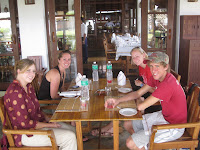Nancy and I were still pretty exhausted by the last day in India, but we wanted to get out. So, we checked to see if there were any vacant seats on the SAS trip to the backwater, and there were, so we climbed aboard. Everyone was trying to make the most of the last day and going in lots of different directions, and a SAS trip is a good way for the brain-dead to see something and get fed when you have no more energy for planning or negotiating.
We got on the bus early, so we got the front seat. The advantages of the front seat will soon become apparent. Not only could you see vehicles coming straight at you on narrow roads, but you could be the first ones to see other neat sights.
How often do you see someone riding down the side of a highway on an elephant, talking on a cell phone? Our driver stopped for a closer look. Elephants are used primarily for temple festivals and moving timber. Timber is still imported here since they don't raise enough.
The other advantage to being in the front is that you get to interact more with the guide who usually carries on a narrative over a PA system. It's hard to believe that a lot of the students prefer to talk among themselves about mundane things like computer games instead of hearing the narrative. We learned early on to get as near the front of the bus as possible.
Some little tidbits from our great guide: In Kerala, for every 2 km, you will probably find 1) a Hindu temple 2)a Catholic church 3) a Mosque 4) a wine shop (state run) 5) a school and 6) a hospital.
Bananas are very popular.

And the local kids are very friendly.
Our trip took us through western Kerala, home of several industries including coir based on the fiber from coconuts. This was more automated than the one we had seen in Nagarcoil. Our guide explained that they know how to make 65 items from the coconut. That's certainly a sustainable item.
Our destination was Alappuzha, one of the jumping off places for the Backwater. The Backwater is a system of canals, rivers, lakes and assorted waterways where people have fished, grown rice and lived. Because of the water, many people lived on the houseboats, but they are mostly now tourist attractions complete with air conditioning, satellite tv and probably internet. Honeymooners make this a favorite destination. The bamboo tops have to be re-done every year, so that is a growth industry.
We unloaded from the bus and rode on one of the ferries through the waterways, admiring the houseboats and hoping that the area could stay natural, but the hotel in the background argues that it can't.
We saw how the people live along the rice paddies which was in stark contrast to how the way we ate our lunch.
 The locals travel by boat--some on a ferry to work the rice paddies.
The locals travel by boat--some on a ferry to work the rice paddies.The kids find any dry area to play cricket.
One of the big events here is when this snakeboat is filled with 100 men to participate in races. This community came in second last year. We saw temples, people fishing, kingfishers, and all the local color and headed back to the ship.
As we passed through all the layers of security, I gave each of the security guys a tootsie roll and even this guy with the machine gun thanked me. Then we watched a couple of folks run for the ship to sneak by without dock time at the next port.
Then, the Captain fired up the engines, the tugboats hooked up and we headed away from a beautiful country, filled with contrasts and wonder and interesting people.
















That photo of the guy riding an elephant and talking on a cell phone is a PERFECT reflection of India.
ReplyDeleteLoved all your posts from India; thanks for sharing.